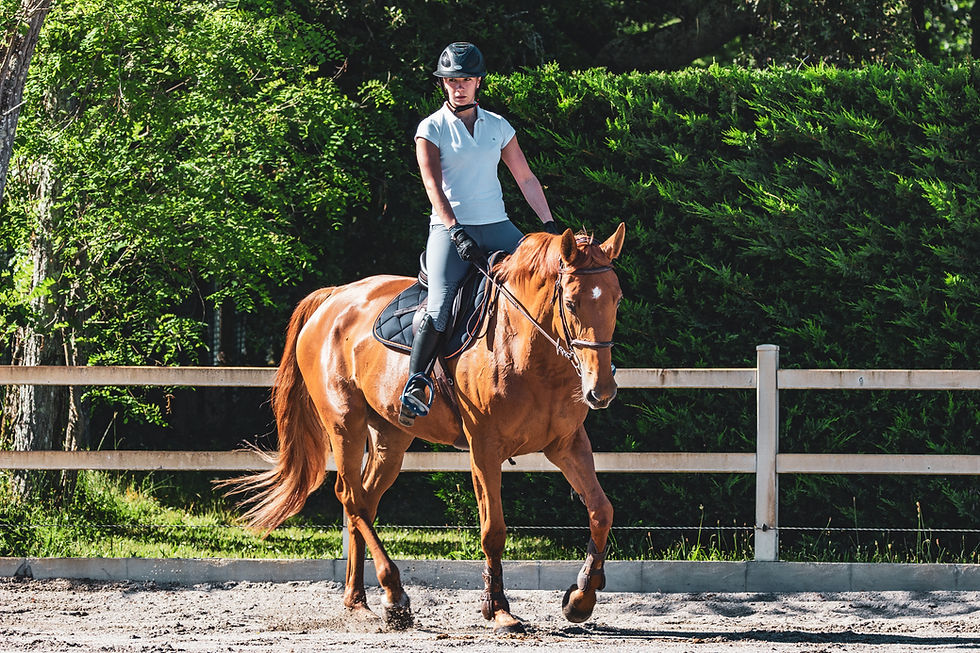Should You Use Hay Bags or Feed Hay From the Ground? Why Hay Pillows are a Great Option.
- AHLERI Equine Products

- Jun 16
- 2 min read
Ever wonder if how you feed hay affects your horse's topline? Spoiler: It does!

🐴 Why Feeding Naturally Matters for Your Horse’s Spine
1. Mimics natural grazing postureIn the wild, horses graze with their heads and necks low—mirroring a posture that engages their entire spine correctly. Studies using geometric morphometrics show that feeding from ground level supports the ideal back and neck alignment—dubbed the "natural feeding position"—while higher feeders distort this posture (horsesinsideout.com, pmc.ncbi.nlm.nih.gov).
2. Reduces strain on back and neck musclesResearch indicates that high haynets shortens back muscle engagement and alters jaw/neck angles, potentially increasing stress on the thoracolumbosacral region (thehorse.com).
3. Promotes spinal mobility and “passive physio”Variable feeding heights—even slightly lower feeders—have been shown to encourage subtle, beneficial spinal flexion and extension. These postures act like a gentle physiotherapy session, improving muscle suppleness over time (thehorsesback.com).
4. Enhances respiratory and digestive healthA low feeding posture helps maintain optimal airway and digestive tract positioning. With the neck lowered naturally, airflow and food passage are smoother—feeding ground-level supports this better than elevated feeders.
5. Reduces risk of vertebral or back issuesChronic unnatural feeding posture may contribute to spinal pathology over time—leading to muscle atrophy, reduced flexibility, and back pain (physio-pedia.com).
🪶 Feeding Solutions and Hay Pillows That Support Natural Alignment
Heica Fluffy Feeder (by AHLERI – official US reseller)
Designed for ground-placement and scattered hay distribution, it offers the benefits of slow feeding without forcing horses into unnatural postures. Its fluffy design encourages natural “nose-down” grazing that preserves correct mandibular angles and spinal alignment. The 6cm net is the most popular, but the 4cm is best for horses who eat quickly!
🧭 Feeding Posture at a Glance
Feature | Ground/Low-Level Feeding | High/Hung Haynets |
Back and neck alignment | Remains natural and fluid (horseoriginals.com) | Altered posture, shortened back muscles |
Muscle engagement | Encourages healthy flexion/extension moves | Leads to stiffness and strain |
Jaw and mandibular angle | Maintenance of normal angles | Restriction and compression |
Respiratory/digestive effect | Optimal airway and gut alignment | Slight compromise due to head elevation |
Feeding behavior | Natural grazing pace, slow & satisfying | Slow feeder necessary, but posture riskier |
✅ Best Practices for Feeding That Supports Natural Alignment
Place feeders close to ground level to replicate natural grazing.
Rotate heights occasionally (as gentle physiotherapy) but remain near ground height.
Use slow-feeding tools like hay pillows and the Heica Fluffy Feeder to mimic ground grazing pace without forcing elevation.
Monitor posture during feeding: ideal stance = neck approximately 15° below withers; anything above impairs alignment .

🏁 Final Take
Feeding from a natural, ground-level height is more than a comfort choice—it supports your horse’s spinal health, respiratory function, and digestive efficiency. It aligns with instinctual grazing behavior and reduces physical strain. The Heica Fluffy Feeder offers an innovative, research-backed solution that combines the benefits of slow feeding with naturally supportive posture.
_edited.png)
_edited.png)
.png)







Comments